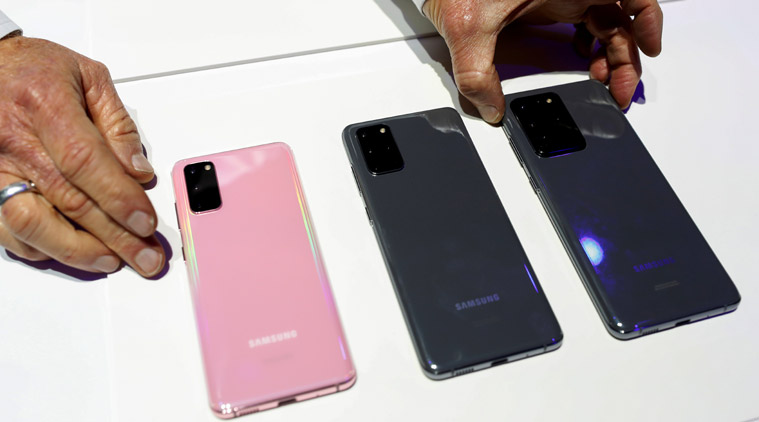 What’s unique about the Galaxy S20, S20+ and Galaxy S20 Ultra? We highlight all the key differences. (Image source: Reuters)
What’s unique about the Galaxy S20, S20+ and Galaxy S20 Ultra? We highlight all the key differences. (Image source: Reuters)
Samsung is taking a leap by going straight to the S20 series, skipping the S11 nomenclature, and there are three new phones this time as well. The Galaxy S20 phones sport major changes, especially on the camera front and all variants now include 5G support.
This time there’s no ‘E’ variant, instead, there’s the Galaxy S20, S20+ and the S20 Ultra. All three come with a much-hyped Space zoom or 100X zoom feature. Further, the top-end Ultra variant gets a 108MP main camera. The cameras are clearly the focus with the Galaxy S20.
There are other key highlights as well. The new flagships also feature a higher 120Hz refresh rate screen and an ultrasonic fingerprint sensor. All three offer big battery support as well. But what differentiates each phone? We take a look at the key specifications of the Samsung Galaxy S20, Galaxy S20+ and Galaxy S20 Ultra.
Samsung Galaxy S20 Ultra: Full specifications and features
Samsung Galaxy S20 Ultra is the most premium of the lot and the most expensive as well at $1399 and this comes in a 5G/LTE variant. On conversion that’s Rs 99,000 plus nearly, and the India price could be even higher, if it comes to the market.
The S20 Ultra also sports the largest display out of the three phones, at 6.9-inches this is nearly a mini-tablet. This is Quad HD+ resolution screen of course with a pixel density of 511 ppi and Samsung is calling this a “Dynamic AMOLED 2X display,” with Samsung promising cinema quality visuals.
The screen supports a higher 120Hz refresh rate, which means smoother animations, faster graphics rendering, though the standard rate is 60 Hz. The device is HDR10+ compatible as well.
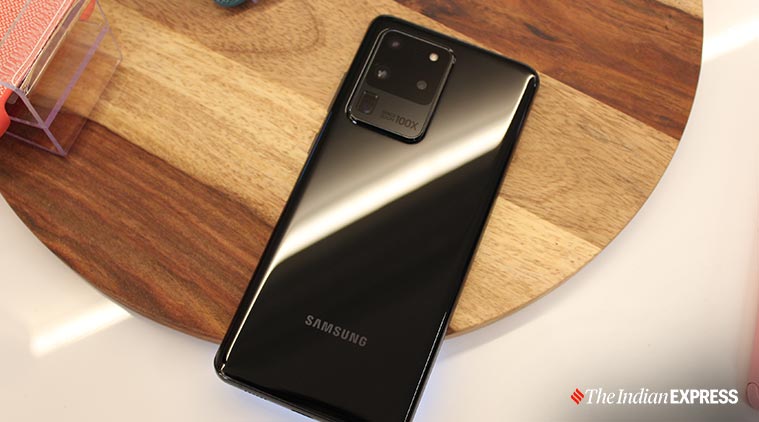 Samsung Galaxy S20 Ultra is the most premium of the lot and the most expensive as well. (Express photo: Sneha Saha)
Samsung Galaxy S20 Ultra is the most premium of the lot and the most expensive as well. (Express photo: Sneha Saha)
Samsung Galaxy S20 Ultra sports four rear cameras at the back. This includes a combination of a main 108MP wide-angle camera with 79-degree field-of-view and f/1.8 aperture, a secondary 48MP telephoto camera with f/3.5 aperture, and third 12MP ultra-wide camera with 120-degree field-of-view. The fourth is a Depth vision or ToF (Time of Flight) sensor for accuracy in portrait shots.
The Ultra supports Samsung’s new Space Zoom feature along with 10x Hybrid Optic Zoom, and Super Resolution zoom up to 100X. The selfie camera is 40MP with 80-degree field-of-view and f/2.2 aperture.
Read our first impressions of the Galaxy S20 as we had a chance to check these out in San Francisco
In terms of processor, the Galaxy S20 Ultra is powered by the latest Qualcomm Snapdragon 865 processor, which supports 5G. In some markets, the phone will launch with Samsung’s own Exynos 990 processor. Samsung has also bumped up the RAM as the Galaxy S20 Ultra comes in 12GB and 16GB RAM options. Also, this is LPDDR5 RAM, which is said to enable 1.5X faster data transfers than LPDDR4 used on the Galaxy S10 series. The internal storage options are 128GB, 256GB, and 512GB, expandable up to 1TB via a microSD card slot.
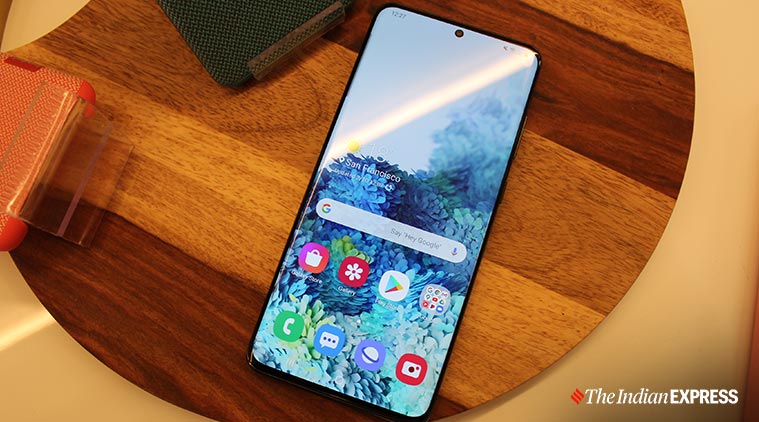 In terms of processor, the Galaxy S20 Ultra is powered by the latest Qualcomm Snapdragon 865 processor, which supports 5G. (Express photo: Sneha Saha)
In terms of processor, the Galaxy S20 Ultra is powered by the latest Qualcomm Snapdragon 865 processor, which supports 5G. (Express photo: Sneha Saha)
Samsung Galaxy S20 Ultra is backed by a 5,000mAh battery with support for Fast Wireless Charging 2.0 and Wireless PowerShare.
For authentication, Samsung has used ultrasonic fingerprint sensor and face recognition. Sensors on the device include Accelerometer, Barometer, Gyro, Geomagnetic, Hall, Proximity, and RGB Light. There’s IP68 rating for water and dust resistance.
Samsung brings back nostalgia with Galaxy Z Flip; here’s what it feels like
The Galaxy S20 Ultra measures 166.9 x 76.0 x 8.8mm and weighs 220 gms.
Samsung Galaxy S20+: Full specifications and features
The Galaxy S20+ starts at a price of $1,199 for the 5G variant, though there is a 4G LTE only variant. That’s around Rs 85,000 plus on conversion. The price for the 4G variant has not been announced yet.
Samsung Galaxy S20+ gets a slightly smaller 6.7-inches screen. This is also a Dynamic AMOLED 2X quality with Quad HD+ resolution and support for HDR 10+. The higher 120 Hz refresh rate is offered here as well.
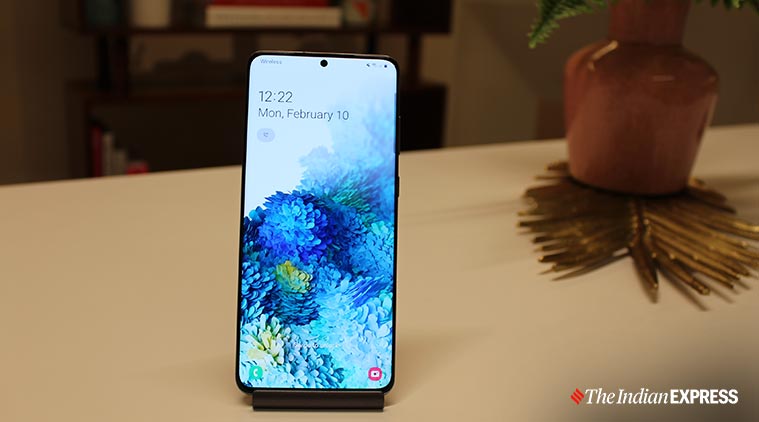 Samsung Galaxy S20+ gets a 6.7-inches Dynamic AMOLED 2X display of Quad HD+ resolution. (Express photo: Sneha Saha)
Samsung Galaxy S20+ gets a 6.7-inches Dynamic AMOLED 2X display of Quad HD+ resolution. (Express photo: Sneha Saha)
The Galaxy S20+ also features four rear cameras, though with there is no 108MP camera here. The rear camera setup includes a 64MP telephoto lens with f/2.0 aperture, 12MP ultra-wide camera with 120-degree field-of-view, 12MP wide-angle lens with f/1.8 aperture, and a fourth Depth vision sensor.
Space Zoom, Hybrid Optic Zoom up to 3X is supported on the Galaxy S20+ as well. However, up to 30X Super Resolution zoom on the Galaxy S20+ unlike up to 100X on the Ultra. The front camera is 10MP with f/2.2 aperture.
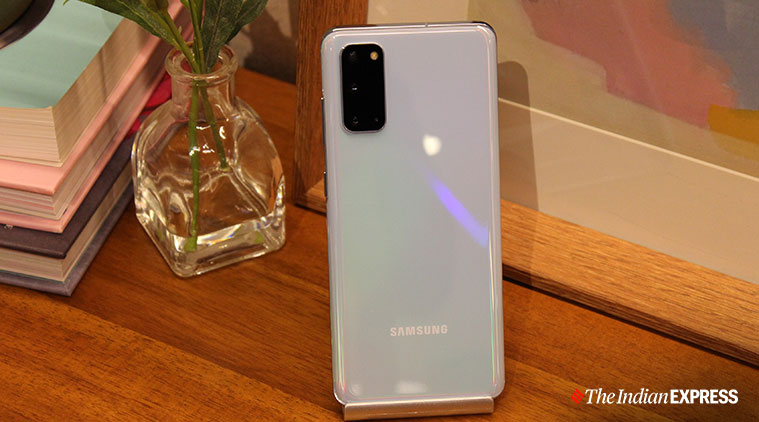 Samsung Galaxy S20+ packs a smaller 4,500mAh one with support for Fast Wireless Charging 2.0 and Wireless PowerShare. (Express photo: Sneha Saha)
Samsung Galaxy S20+ packs a smaller 4,500mAh one with support for Fast Wireless Charging 2.0 and Wireless PowerShare. (Express photo: Sneha Saha)
Samsung Galaxy S20+ also packs the Qualcomm Snapdragon 865/Exynos 990 processor coupled with either 8GB or 12GB LPDDR5 RAM and 128GB/512GB ROM. Just like the Ultra, the storage is expandable up to 1TB via a microSD card slot.
The battery is a smaller 4,500mAh one with support for Fast Wireless Charging 2.0 and Wireless PowerShare. Ultrasonic fingerprint sensor and face recognition are supported as well. The sensors remain the same, including Accelerometer, Barometer, Gyro, Geomagnetic, Hall, Proximity, and RGB Light.
Dimensions of the Galaxy S20+ are 161.9 x 73.7 x 7.8mm and it is lighter at 186 gm.
Samsung Galaxy S20: Full specifications and features
Samsung Galaxy S20 is the most affordable with the smallest screen size, though the 5G variant price starts at $999 or nearly Rs 71,000 on conversion.
The base Galaxy S20 gets three rear cameras, instead of four we see on the other two phones. In terms of specifications, the Galaxy S20 sports a 6.2-inch Dynamic AMOLED 2X display with Quad HD+ resolution and support for 120 Hz refresh rate, HDR10+ content.
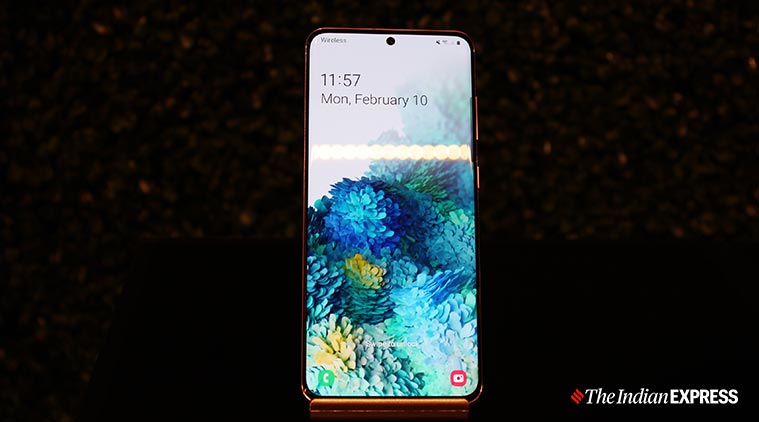 Samsung Galaxy S20 is the most affordable with the smallest screen size and three rear cameras instead of four on the other two phones. (Express photo: Sneha Saha)
Samsung Galaxy S20 is the most affordable with the smallest screen size and three rear cameras instead of four on the other two phones. (Express photo: Sneha Saha)
Samsung Galaxy S20 gets three back cameras with a 64MP telephoto sensor with f/2.0 aperture, 12MP ultra-wide lens with 120-degree field-of-view, and a 12MP wide-angle camera with f/1.8 aperture. There’s also support for Space Zoom, Hybrid Optic Zoom 3x, and Super Resolution Zoom up to 30X like on the Galaxy S20+. The front camera is also the same as the Plus variant – 10MP with f/2.2 aperture.
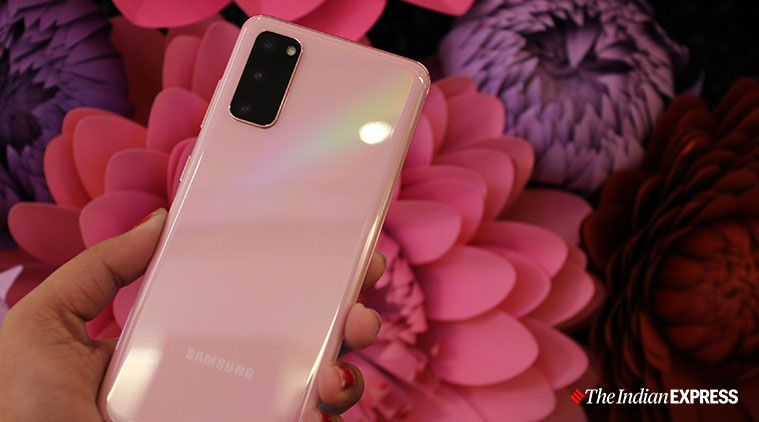 Samsung Galaxy S20 gets three back cameras with a 64MP main sensor. (Express photo: Sneha Saha)
Samsung Galaxy S20 gets three back cameras with a 64MP main sensor. (Express photo: Sneha Saha)
Samsung Galaxy S20 is powered by the same Snapdragon 865 processor/Exynos 990 with 8GB or 12GB LPDDR5 RAM options. The internal storage is 128GB, which is expandable up to 1TB via a microSD card slot. When it comes to battery, the Galaxy S20 is backed by a 4,000mAh and there’s support for Fast Wireless Charging 2.0 and Wireless PowerShare as well.
Other features include IP68 rating, ultrasonic fingerprint sensor and face recognition. Sensors on the Galaxy S20 include Accelerometer, Barometer, Gyro, Geomagnetic, Hall, Proximity, and RGB Light. It measures 151.7 x 69.1 x 7.9mm and weighs 163 gms, which makes it the lightest of the three.